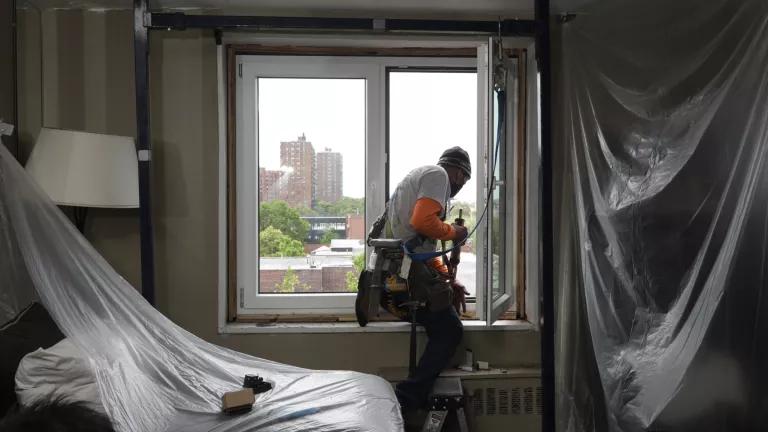San Jose Takes Nearly All New Buildings All-Electric
San Jose becomes the largest U.S. city to take new buildings all-electric.

San José, CA
The San José City Council passed an expansion of its all-electric new construction ordinance to keep fossil fuels out of new homes and businesses at the December 15th Council meeting. As the 10th-largest city in the country, San José is now the largest U.S. city to require virtually all new buildings to be all-electric.
Under the newly expanded ordinance, new mid- and high-rise construction, including both residential and commercial development, must be all-electric beginning August 2021, with limited exemptions. This action accelerates San José’s transition to a fully electrified and energy efficient building stock, which will be critical to meeting the city’s ambitious climate goals.
San José will join fellow Bay Area cities San Francisco, Oakland, and Berkeley along with nearly 40 other cities and counties in the state in approving codes that require or encourage transitioning from gas infrastructure to electricity. San Francisco passed its ordinance just last month, while Berkeley was the first in the country to pass an all-electric new-building ordinance in July 2019. Oakland also approved a similar code on the same day as San José.
San José’s all-electric new-buildings ordinance has been supported by the Bloomberg Philanthropies American Cities Climate Challenge with deep technical assistance from the project partners: Association for Energy Affordability, New Buildings Institute, and NRDC.
Speakers at the council meeting including youth activists, labor representatives, local parents, environmental groups, and others demonstrated widespread community support for all-electric new construction. Sierra Club, Menlo Spark, Mothers Out Front, Silicon Valley Youth Climate Action, SV@Home, and International Brotherhood of Electrical Workers all spoke in favor of the expansion of the ordinance.
Making new buildings safer and healthier
Getting gas out of buildings is critical. “Natural” (aka fossil) gas is largely gas that is fracked, blasted out of the earth in incredibly damaging ways. It consists mainly of methane, a powerful climate pollutant that traps more than 80 times as much heat as carbon dioxide, and 90% of California’s natural gas is imported from out of state, making it more susceptible to methane leaks during transport.
Gas can be dangerous to human health. Gas stoves, for example, release carbon monoxide, nitrogen compounds, formaldehyde, and other air pollutants that can exacerbate existing respiratory and health conditions, including asthma. If stoves are not properly vented, studies have found that cooking with gas can lead to kitchen concentrations of nitrogen oxides considered illegal under outside air pollution standards and can increase the risk of asthma symptoms for children living in the home by as much as 42 percent. Meanwhile, outdoor air pollution increases from emissions that either eventually seep out or are vented directly to the outside.
San José's path to clean-energy buildings
Today’s vote is the latest step San José has taken toward meeting the goals of Climate Smart San José, the city’s Paris-aligned GHG reduction plan. In September 2019, Mayor Liccardo and four City Councilmembers signed onto a city resolution declaring a climate emergency. The resolution pledged ambitious actions to mitigate climate change, including prohibiting natural gas in new construction projects citywide.
Shortly after the Climate Emergency Resolution was signed, the city adopted the original all-electric new buildings ordinance in October 2019 in tandem with San José’s “Reach Code.”
The original ordinance required only some new construction to be all-electric —municipal, single-family, and low-rise multifamily buildings— and created additional voluntary electrification incentives for buildings not covered by the ordinance. However, to act on the Climate Emergency Resolution, Councilmembers immediately directed city staff to look into expanding the ordinance to cover more buildings.
After an extensive technical analysis and a robust engagement process convening developers, affordable housing representatives, architects, engineers, and industry associations, city staff forged ahead with a draft expansion of the ordinance to nearly all building types and sizes. With the support of technical experts and local partners, staff drafting the ordinance worked to ensure this new expansion will benefit the community while significantly reducing carbon pollution from local buildings.
Advocates hoped for a cleaner code
While the approved code represents a significant step in the right direction, it could have been stronger. It includes an exemption for fuel cells —which generate electricity using mainly natural gas from underground pipelines, the very technology the city is aiming to phase out. These gas-powered fuel cells emit more than four times as much carbon dioxide as power from the local utility.
The City Council's approval of this last-minute request from Bloom Energy will now allow some new industrial and commercial buildings to rely at least partially on fossil fuels. The second reading at council may offer an opportunity to narrow or remove the exemption, which is currently scheduled to sunset in 2024.
Leading the way with fellow California cities

San Francisco, Berkeley, and San José, CA
With a wave of California cities opting out of gas infrastructure in new buildings, Governor Gavin Newsom could act on his climate agenda to electrify buildings statewide. The California Energy Commission and the Building Standards Commission are currently considering updates to its energy standards, and with buildings responsible for roughly 25 percent of California’s GHG emissions, building electrification could go a long way toward meeting California State Senate Bill 32’s goal to reduce GHG emissions by 40 percent below 1990 levels by 2030. San José joins the many cities inspiring the state to follow their lead.




